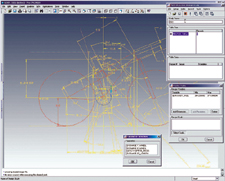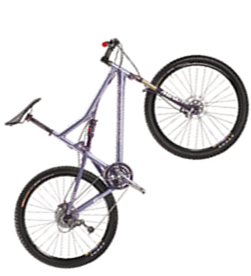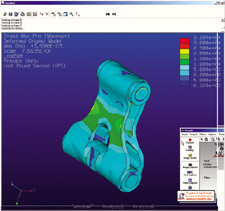Latest News
August 1, 2004
By Louise Elliott
The popularity of bicycling in the U.S. peaked in the 1970s when a flood of inexpensiveimported bikes entered the market. Things slowed, but in the mid 1980s, the mountainbiking segment started growing, and now represents about 40 percent of all bikessold in the U.S. While total bike sales have dropped since 1994, Santa Cruz Bicycles(SCB; Santa Cruz, CA; website ) of Santa Cruz, California, has bucked the trend and continued to gain marketshare.
At Helen’s Cycles in Santa Monica, California, a Santa Cruz dealer, store managerTony Ray describes a Santa Cruz model, called the Blur, “very hard to keep instock.” The primary reason for the Blur’s success, he believes, is its uniquesuspension and light weight. Mountain Biking Magazine voted the Blur “2003 XCBike of the Year.”

Top: The Blur is Santa Cruz Bicycles’ (SCB) line leader and the cross-countrychoice among riders ready to spend a little more for advanced technology likethe virtual pivot point (VPP) design. VPP helps eliminate unwanted and energy-wastingshock compression during pedaling. Right: Pro/Engineer from PTC has allowed designersat SCB to improve the engineering of its award-winning bicycles. In fact, SCBuses PTC analysis and modeling programs within Wildfire 2.0 for all aspects ofthe manufacturing cycle from design and behavioral analysis to advanced surfacingand structural simulation.
SCB, a 43-person company founded in 1993, designs and produces full-suspensionbicycles for almost every discipline of mountain biking, including downhill, freeride, and cross country. These customizable, high-performance bikes cost between$1,800 and $5,000. Over the years, SCB kept building on its experience, developingsingle pivot-point full-suspension bikes and then looking for ways to take performanceto the next level. The company gives PTC’s Pro/Engineer software a lot of creditfor its success in competing with both smaller, high-end bike companies and largerbroad-based companies.
 SCB has designed a number of four-bar linkage bikes, and for some bikes—includingthe Blur—developed a suspension system derived from a patented virtual pivot point(VPP) design that enables the bike “to sprint without bobbing, yet absorb shocksand bumps easily,” according to company literature. The VPP eliminates unwantedshock compression during pedaling by applying some of the pulling force from thechain to counteract the motion. The link configuration and axle path means theBlur continues to absorb bumps during pedaling, unlike other designs that effectivelylock out the rear suspension by applying too much chain-pulling force.
SCB has designed a number of four-bar linkage bikes, and for some bikes—includingthe Blur—developed a suspension system derived from a patented virtual pivot point(VPP) design that enables the bike “to sprint without bobbing, yet absorb shocksand bumps easily,” according to company literature. The VPP eliminates unwantedshock compression during pedaling by applying some of the pulling force from thechain to counteract the motion. The link configuration and axle path means theBlur continues to absorb bumps during pedaling, unlike other designs that effectivelylock out the rear suspension by applying too much chain-pulling force.
To bring that new suspension design to market, SCB used a mixture of PTC’s analysisand modeling capabilities, all accessible within Wildfire 2.0. Specifically, SCBused behavioral modeling for initial analysis and design; MCAD to give the bikeits structure; advanced surfacing for aesthetics; mechanism dynamics to analyzeclearances and loads; and structural simulation for failure analysis.
Behavioral Modeling is the Key“The most important capability for us is behavioral modeling,” says David Earle,SCB’s director of engineering. “This is a super-flexible design-optimization engine.“The engineers use it to locate important pivot points, and keep track of the wheelpath and shock rate.
He sums up just how important behavioral modeling is to SCB’s design process:“We use behavioral modeling to locate the pivots that control the rear wheel’saxle path and shock rate. All four-bar linkage bikes exhibit a virtual pivot point;‘virtual’ because it is in constant motion. Our VPP system differs from otherbikes on the market because we employ a patented system that uses counter-rotatinglinks.”
Although bikes with the VPP system are very stable to ride, Earle says, “Comparedto conventional suspensions, this is a vastly more difficult system to solve,and inherently unstable and unpredictable to design. However, it allows for amuch more tunable, controllable axle path.” Earle compares the problem to jetfighter design, saying both are inherently unstable but vastly superior when understoodand mastered. “A tunable axle path allows us to tune the suspension to optimalperformance in all ranges of the travel,” he says, “minimizing pedal-induced movementand also improving small and large bump feel. We use behavioral modeling to helpus find…where the pivots need to go. Otherwise, ]it] would be like throwing darts…inthe dark.”

This FEA analysis of the main link examines the stresses that are likely to beapplied to one component of the virtual pivot-point technology. This link is onehalf of a counter-rotating link system and is mounted near the seatstays. Thetwo links work together to control the rear wheel’s axle path.
John Buchowski, product line manager for Pro/Engineer Wildfire, salutes the SCBapproach. “Doing functional simulation early in the process is the key to efficientdesign, because the less we understand, the greater the risk,” he says. Behavioralmodeling, built upon the optimization engine in Pro/Mechanica, allows up-frontcapture of design intent explicitly within the CAD program. “The user can determinesuch critical information as the center of mass, perform both geometric and surfacemeasurements, and save the results as design features,” says Buchowski.
Bicycle designers can start with a 2D sketch in Pro/E, to which they can addjoints and connections, and work out other linkages. “They can connect these byusing built-in joints, such as a pin joint and its connections,” Buchowski says.“They can drag parts around with the mouse to try different versions. If theyneed to know pivot points, as SCB does, they can work out how much shock willbe displaced with different amounts of rear-wheel travel. They can create an analysisfeature to measure displacement on the sketch, or change dimensions and see theeffects, using a menu pick for measurement and a single button to indicate resultsthey want to keep.”
Pro/Engineer’s behavioral modeling contains four tools to obtain probabilisticoptimization results: sensitivity studies that can be performed to determine theeffects of specific parameter changes; optimization for specific requirements;feasibility studies to find possible solutions without specific requirements;and multiobjective studies based on design of experiments. Users can go back andforth among these tools as needed, and save any results they want as design features.
Going Beyond Previous Expections
“Once we have the information we need from behavioral modeling, we use CAD andcreate the hard form of the bike around the pivot points,” Earle says. “We cancreate the ‘look’ we want with advanced surfacing later on.”
After assembling the solid MCAD model, SCB uses Pro/Engineer Mechanism Dynamicsto perform motion simulation, apply loads and force, and determine whether anyinterferences exist. From that point, they go on to structural analysis with Pro/Mechanica.At the end of the design cycle, SCB has used three analysis tools, and the engineersfeel confident about the design.
Each of the tools mentioned can be selected by means of a menu pick within theWildfire interface, and each tool works inside the same environment, making iteasy to move back and forth among them.
Earle reports, “What used to take six or seven hours now takes five minutes withthis software. By saving so much time at each stage, the engineering departmentgained an additional 415 minutes per simulation, and we used that time to refinethe suspension system further, to levels previously impossible.”
SCB’s success with the Blur has led the company to take steps that will helpit “break away from the pack,” says Earle. “We’ve doubled the size of our Californiafacility and have made the move to Pro/Engineer Wildfire 2.0. We plan to releasefour new bikes over the next year or so. We expect slightly higher revenue thisyear, and a large jump in 2005.”
Contributing editor Louise Elliott is a freelance writer based in California. Offer Louise your feedback on thisarticle through Desktop Engineering Feedback.
Subscribe to our FREE magazine, FREE email newsletters or both!
Latest News
About the Author
DE’s editors contribute news and new product announcements to Digital Engineering.
Press releases may be sent to them via [email protected].







